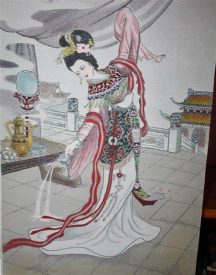Textile art has a long history . In China, examples of clothing have been found dating back thousands of years. But many artists who specialized in textiles are unknown to us today because their work tended to be used in everyday life (think about things like quilts and coverlets). We see what they made, but don't always know their names. This is true for early textile art like tapestries.

A tapestry was a very large weaving made by hand on a vertical loom. Imagery could be narrative or decorative and early tapestries had a basic purpose: to serve as insulation. These large fabric works hung on castle walls, protecting inhabitants from large drafty rooms and damp cold weather. Many tapestries were made in Flanders (today, the northern part of Belgium), which in medieval times was a weaving center. Threads were dyed a variety of colors, all from natural sources, and skilled weavers were often father and son teams. One generation passed on its skill to the next.
The process of making a tapestry began with a cartoon, a full-sized color pattern. Weavers used the cartoon as a guide to weave the colored threads on the loom, replicating the chosen pattern. One example is the Lady and the Unicorn tapestry series, a set of six images woven in Flanders of wool and silk around 1511. You might have seen them in books or stories of the Middle Ages. Each is a little different but all feature an elaborately clothed woman with a smiling fanciful unicorn and other creatures (often a lion) on a red background dotted with foliage and small animals.
One famous early textile work isn't a tapestry, despite its name. The Bayeux Tapestry is actually an elaborate example of embroidery, which is the decorating of fabric with stitches and colored threads. Made of eight pieces of linen sewn together, it is 231 feet long and almost twenty inches high with elaborate images embroidered in eight colors of wool yarn. Just think of how long it would take you to sew something like that!